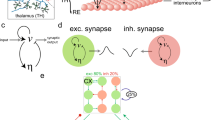Abstract
We have previously proposed that electrocortical activity (EEG) arises as a manifestation of linear waves generated by resonance among telencephalic neurones, and that this activity is controlled in part by ascending neurones from the brain-steim, which regulate the damping of each resonance. The presentexperiments focus on a specific class of ascending neurones, the mesotelencephalic dopaminergic cells, because these cells are thought to mediate important psychological effects, and are conveniently subject to selective lesion. A critical test of the theory is undertaken, by performing selective unilateral lesion, assessing the changes in the power spectrum of the EEG attributable to lesion, and determining whether the changes in phase of the EEG correspond to that predicted from the changes in power. Results support the theory, although the model order applicable in these experiments is inadequate. The consequences of these findings for automata theory, linear network theory and their application to mammalian brains are briefly discussed.
Similar content being viewed by others
References
Arbib, M.A.: Brains, Machines, and Mathematics, New York: McGraw-Hill 1964
Berkhout, J., Walter, D.O., Adey, W.R.: Alterations of the human electroencephalogram induced by stressful verbal activity. Electroenceph. Clin. Neurophysiol. 27, 457–469 (1969)
Furness, J.B., Heath, J.W., Costa, M.: Aqueous aldehyde (Faglu) methods for the fluorescence histochemical localization of catecholamines and for ultrastructural studies of central nervous tissue. Histochem. 57, 285–295 (1978)
Gevins, A.S., Zeitlin, G.M., Doyle, J.C., Yingling, C.D., Schaffer, R.E., Callaway, E., Yeager, C.L.: Electroencephalogram correlates of higher cortical functions. Science, 203, 66, 665–667 (1979)
Hokfelt, T., Ungerstedt, U.: Specificity of 6-hydroxydopamine induced degeneration of central monoamine neurones. An electron and fluorescence microscopic study with special reference to intracerebral injection on the nigro-striatal dopamine system. Brain Res. 60, 269–297 (1973)
Konig, J.R.F., Klippel, R.A.: The rat brain. A stereotaxic atlas of the forebrain and lower parts of the brain stem. New York: Krieger 1963
Ljungberg, T., Ungerstedt, U.: Sensory inattention produced by 6-hydroxydopamine-induced degeneration of ascending dopaminergic neurones in the brain. Exp. Neurol. 53, 585–600 (1976)
Marshall, J.F., Turner, B.M., Teitelbaum, P.: Sensory neglect produced by lateral hypothalamic damage. Science 174, 523–525 (1971)
Marshall, J.F., Richardson, S., Teitelbaum, P.: Nigrostriatal bundle damage and the lateral hypothalamic syndrome. J. Comp. Physiol. Psychol. 87, 808–830 (1974)
Marshall, J.F.: Somatosensory inattention after dopamine-depleting intracerebral 6-OHDA injections: spontaneous recovery and pharmacological control. Brain Res. 177, 311–324 (1979)
Nunez, P.L.: Electric fields of the brain. The neurophysics of the EEG. New York, Oxford: Oxford University Press 1981
Pribram, K.: Languages of the brain. New Jersey: Prentice-Hall 1971
Walter, D.O., Kado, R.T., Rhodes, J.J., Adey, W.R.: Electroencephalographic baselines in astronaut candidates estimated by computation and pattern-recognition techniques. Aerospace Med. 38, 371–379 (1967)
Wise, R.A.: Catecholamine theories of reward: a critical review. Brain Res. 152, 215–247 (1978)
Wise, R.A., Bozarth, M.A.: Brain substrates for reinforcement and drug self-administration. Prog. Neuropsychopharmacol. 5, 467–474 (1981)
Wright, J.J., Craggs, M.D.: Intracranial self-stimulation, cortical arousal and the sensorimotor neglect syndrome. Exp. Neurol 65, 42–52 (1979)
Wright, J.J., Ihaka, G.R.: A preliminary mathematical model for lateral hypothalamic regulation of electrocortical activity. Electroenceph. Clin. Neurophysiol. 52, 107–115 (1981)
Wright, J.J., Kydd, R.R.: A linear theory for global electrocortical activity and its control by the lateral hypothalamus. Biol. Cybern. 50, 75–82 (1984)
Wright, J.J., Kydd, R.R.: A test for constant natural frequencies in electrocortical activity under lateral hypothalamic control. Biol. Cybern. 50, 83–88 (1984)
Wright, J.J., Kydd, R.R.: Inference of a stable dispersion relation for electrocortical activity controlled by the lateral hypothalamus. Biol. Cybern. 50, 89–94 (1984)
Author information
Authors and Affiliations
Rights and permissions
About this article
Cite this article
Wright, J.J., Kydd, R.R. & Lees, G.J. Amplitude and phase relations of electrocortical waves regulated by transhypothalamic dopaminergic neurones: A test for a linear theory. Biol. Cybern. 50, 273–283 (1984). https://doi.org/10.1007/BF00337077
Received:
Issue Date:
DOI: https://doi.org/10.1007/BF00337077




